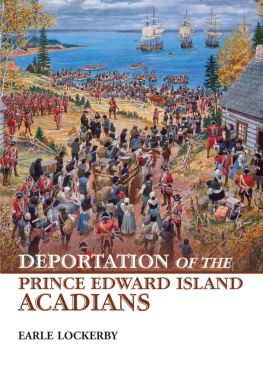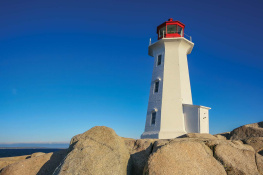S HIPWRECKS AND S AILORS
OF
P RINCE E DWARD I SLAND
R OBERT C. P ARSONS
P OTTERSFIELD P RESS , L AWRENCETOWN B EACH , N OVA S COTIA , C ANADA
Copyright 2021 Robert C. Parsons
All rights reserved. No part of this publication may be reproduced or used or stored in any form or by any means graphic, electronic or mechanical, including photocopying or by any information storage or retrieval system without the prior written permission of the publisher. Any requests for photocopying, recording, taping or information storage and retrieval systems shall be directed in writing to the publisher or to Access Copyright, The Canadian Copyright Licensing Agency (www.AccessCopyright.ca). This also applies to classroom use.
Library and Archives Canada Cataloguing in Publication
Parsons, Robert Charles, 1944-
Shipwrecks and sailors of Prince Edward Island / Robert C. Parsons.
Includes index.
ISBN 978-1-897426-45-6
1. Shipwrecks--Prince Edward Island--History. 2. Sailors--Prince Edward Island--History. 3. Seafaring life--Prince Edward Island--History. 4. Prince Edward Island--History. I. Title.
FC2611.P37 2012971.7C2012-903606-4
Cover design: Gail LeBlanc
Pottersfield Press gratefully acknowledges the financial support for its publishing activities from the Government of Canada through the Canada Book Fund (CBF) and the Canada Council for the Arts, and from the Province of Nova Scotia. We are pleased to work in partnership with the Province of Nova Scotia to develop and promote our creative industries for the benefit of all Nova Scotians.
Pottersfield Press
248 Leslie Road
East Lawrencetown, Nova Scotia, Canada, B2Z 1T4
Website: www.PottersfieldPress.com
To order, phone 1-800-NIMBUS9 (1-800-646-2879) www.nimbus.ns.ca
Printed in Canada
C ONTENTS
This year, 2012, I celebrated twenty-five years of researching, reading and writing about ships of the North Atlantic. My primary focus was initially Newfoundland and Labrador, but Ive collected hundreds of ship tales from other Atlantic regions. Among these were scores of stories of Prince Edward Island vessels. There were also accounts of Newfoundland, Nova Scotia and New Brunswick ships wrecked on the Island, and P.E.I. vessels that were lost on foreign shores.
I thought the tales were fascinating, unique, strange, mysterious, and too important to be stored away. I had found these accounts while looking for something else, yet made note of the source or put a copy in my files. All were readily available in archived newspapers, usually stored on microfilm, and available at universities or museums. To augment this core batch of sea accounts, I did a more extensive newspaper search, mainly from P.E.I.s Patriot and Express sent from the National Archives, and found many descriptions of shipping losses from nearly all shores and coves of Prince Edward Island.
Here are tales of survivors of wrecks and of the hardships of mariners and their encounters with ice, fog, rock or other ships, and successful battles against wind and wave. Some are short, especially where a ship disappears or there were no survivors and only pieces of wreckage. Rather than omit this valuable information, I chose to present it despite an unfulfilled need to know more about a mystery of the ocean. Perhaps some future researcher can fill in the gaps.
Stories are arranged chronologically. This volume spans the eighteenth and nineteenth centuries, from 1775 to 1899. Recounted here are tales that happened on or near Prince Edward Island, and wrecks of Island-owned ships that occurred on foreign and usually inhospitable shores.
All stories presented here are true as true as the memory of wreck survivors can interpret them. Often newspapers of the day embellished or enhanced tales of heroism or disaster. Whenever possible, I tried to verify or augment the facts by looking through contemporary published accounts or by searching for death announcements, photos, gravestone inscriptions, scrapbooks, official crew lists, ships statistics, diary reports, folk poems or oral tales of the day.
In my search for information, I had help, especially with photos, from many sources. I particularly single out these (at the risk of omitting other vital sources): Public Archives of Prince Edward Island; Provincial Archives of New Brunswick; A.C. Hunter Library, St. Johns, Newfoundland; Captain Hubert Hall (Shipsearch Marine) of Yarmouth, Nova Scotia; Memorial Universitys Information Services and Maritime History Archives, St. Johns, Newfoundland. Much written material came from archival newspapers of the day preserved on microfilm.
I have made every effort to identify rightful owners and obtain proper permission to reproduce photos or other images. If errors occur in this regard, in the citing of written sources, or the proper identification/spelling of sailors names, please notify me. Efforts will be made in subsequent editions to correct errors.
Robert C. Parsons
Web site: www.atlanticwrecks.com
Prince Edward Island lies in the Gulf of St. Lawrence, just off the coasts of Nova Scotia and New Brunswick. The moon-crescent, cradle-shaped island is just over 125 miles long, and ranges from thirty-seven miles wide to only two and a half miles at its narrowest. It has been called various names. Its native people, the Mikmaq, called it Epekwitk, pronounced Abegweit by the Europeans who followed. Its French pioneers referred to it as Ile St. Jean. To the British it was St. Johns Island until 1798 or 1799 when they changed the name to Prince Edward Island. But today, it is still The Island to those who live there, the smallest of Canadas ten provinces.
Prince Edward Islands natural resources were, and still are, mainly renewable resources. The two most important of economic value are the Islands fertile agricultural soil and the fisheries.
Surrounded by the Atlantic Ocean and prolific fishing grounds, P.E.I. developed an early fishing industry, both its own and from foreign fleets. Groundfish such as cod, hake, flounder and redfish and pelagic species such as herring and mackerel once abounded in the Islands waters, and to a lesser extent exist there today. By the 1850s, American and Nova Scotian fishing schooners worked in the seas just off the Island. The lowly lobster rose to prominence and today many of the provinces coastal communities rely upon shellfish harvesting, particularly lobster and oyster fishing as well as mussel farming.
The economic history of P.E.I. and the movement of those resources have been dominated by the geography of a small island situated a short distance from the mainland. Agricultural produce and manufactured goods had to travel only short distances before they could be loaded aboard cheap water transportation. The forests of the Island provided valuable timber and shipbuilding became a major industry in the mid-1800s. As wooden sailing ships were replaced by steam vessels constructed of iron and steel, the entire industry phased out. According to Marven E. Moore and Nicolas deJongs Launched from Prince Edward Island: A Pictorial Review of Sail, the industry produced approximately 4,500 sailing vessels.
But at the time when shipbuilding went into decline, the export of agricultural products to the United States increased and, by the time of Canadian Confederation in 1867, trade links were well established along the Atlantic seaboard. Potatoes, the dominant cash crop, other vegetables and livestock were loaded aboard P.E.I. vessels for trade; in addition, hundreds of schooners sailed to Island ports to load agricultural products.











